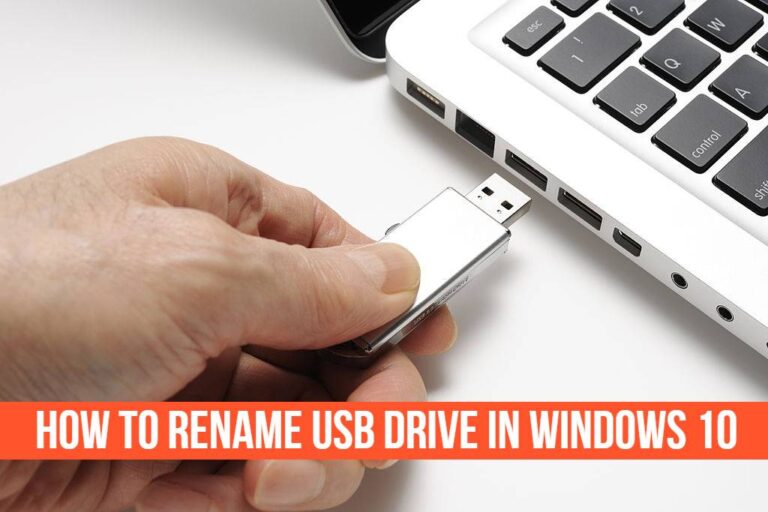
How To Rename USB Drive In Windows 10
Renaming a USB drive is easy, but most people don’t know how to do this on Windows 10. We will show you the quick steps on How to rename a USB drive in windows 10 as it’s not hard at all!
Changing a USB drive name is also very useful, especially if you have a lot of drives connected at a given time. If you have a lot of drives connected, it might get confusing which drive is which. The good thing about renaming a USB drive is that you can rename it with a short name that will help you quickly recognize the drive you need. In this article, you will learn about some methods that can be used to rename a USB drive.
By following the steps below, we’ll show you exactly how to rename your hard drives as well as other devices such as flash drives or external hard drives under Windows 10. It’s very easy once you know where everything is located!
How To Rename USB Drive in Windows 10 – Three Methods
Method 1: Rename USB drives using the Rename option
Step 1: Open File Explorer
Firstly, open file explorer by searching for it in the start menu or by clicking on the Windows icon and typing “file explorer.”
Search for “File Explorer” in the Start menu if you can’t find it to launch the utility.
Step 2: Navigate to This PC (Computer)
Next, navigate to the file explorer window. Click on the This PC (computer) option located at the left pane of your screen.
Step 3: Right-click on your USB drive
Once you’ve clicked that option, right-click on any of the drives (In your case, USB drive) that you would like to rename and select Rename from its context menu.
Step 4: Type Your Desired Name
From here, type in whatever you want to rename that drive into the empty field that has appeared before you, and then hit enter on your keyboard.
Check our article on: Funny USB Name ideas
Method 2: Rename USB drives using Command Prompt
Step 1: Firstly, access Command Prompt by either searching for it in the start menu or by typing “cmd” into the search bar located on the right-hand side of your start menu.
Step 2: Once you’ve typed cmd (or searched for it), hit enter to launch Command Prompt with elevated permissions. After launching a command prompt with elevated permissions, type “diskpart” and hit enter on your keyboard.
Step 3: Once you’ve launched diskpart (this might take a few seconds), type “list volume” and hit enter on your keyboard. This will list all the available volumes of your computer, including those which are connected to USB ports or other accessories.
Step 4: Now that we have listed our volumes, find the one you wish to rename and type “select volume n” (where ‘n’ is the number of your volume). For example, if we were trying to rename our E: drive, we would type: “select volume 2”.
Once selected, type “rename” followed by the name you’d like for this USB drive.
Step 5: Now that we’ve named our drive, we can close diskpart by typing “exit” and hitting enter on your keyboard.
Finally, type “exit” and hit enter in the Command Prompt one more time to close it entirely.
Note: If you’re running Windows 10 Home instead of Windows 10 Pro, then this option will not be available to you. You won’t be able to rename the drive with this method, but you can still rename it using the methods described above.
Method 3: Change USB drive letter using Windows Disk Management
Step 1: Open Windows Disk Management
First, open disk management by searching for it in the start menu or by typing “disk management” into the search bar located on the right-hand side of your start menu.
Note: This is not available in Windows 10 Home. If you’re running Home, then you have to type “create and format hard disk partitions.”
Step 2: Once Disk Management
Launch Disk Management with elevated permissions (Right-click on it and select ‘Run as Administrator’).
Step 3: Find and Select Your Drive
From the list of drives, find the one you’d like to rename and right-click on it. Next, select the “Change Drive Letter and Paths…” You’ll now see a new window called “Change drive letter and paths.”
Here, simply select another drive letter from the drop-down menu and hit apply.
That’s all you need to do! If you followed these steps correctly, then your USB drive should now have a new name.
Conclusion
Renaming USB drives is a very simple process, but it can sometimes be confusing for people who have never done it before. By following the methods above, you should have no issue renaming your USB drive on Windows 10. If one method doesn’t work for you, try another until you get the results you’re looking for!
We hope this article has been helpful to you. Leave a comment below if you have any further questions or concerns regarding this topic, and we’ll get back to you as soon as possible!